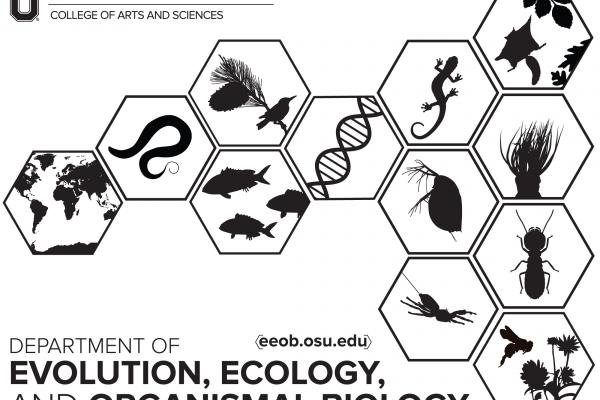March 29, 2019
Publications by EEOB Faculty March 1 - March 31

Relationships between Tertiary relict and circumboreal woodland floras: a case study in Chimaphila (Ericaceae)
Zhen-Wen Liu, Jing Zhou, Hua Peng, John V Freudenstein, Richard I Milne. 2019. Annals of Botany, mcz018, https://doi.org/10.1093/aob/mcz018
Abstract
Background and Aims
Tertiary relict and Arctic/circumboreal distributions are two major patterns of Northern Hemisphere intercontinental disjunctions with very different histories. Each has been well researched, but members of one biome have generally not been incorporated in the biogeographical analyses of the other, and links or transitions between these two biomes have rarely been addressed.
Methods
Phylogenies of Chimaphila were generated based on cpDNA and nuclear ITS, using Bayesian and maximum likelihood methods. A time-calibrated phylogeny was generated using BEAST. Ancestral area reconstruction was inferred using both statistical dispersal–vicariance analysis and a dispersal–extinction–cladogenesis model.
Key Results
The Chimaphila crown group was estimated to have originated in the early Miocene. The lineages of C. umbellata diverged early, but its present circumboreal distribution was not achieved until around the middle Pliocene or later. Sister to this is a clade of four species with Tertiary relict distribution. Among these, two expansions occurred from North America to Asia, probably via the Bering Land Bridge, generating its current disjunctions.
Conclusions
Our data concur with a few other studies, indicating that the circumboreal woodland biome has an older origin than most true Arctic–alpine taxa, having gradually recruited taxa since the early Oligocene. For the origin of Asia–North America disjunctions in Chimaphila, an ‘out-of-America’ migration was supported. It is not clear in which direction Pyroloideae lineages moved between Tertiary relict disjunctions and Arctic/circumboreal distributions; each biome might have recruited species from the other.
Feeding on sexually-active bull moose advances development of the winter tick, Dermacentor albipictus
Jay A.Yoder, Peter J.Pekins, Cameron J.Dobrotka, Kelli A.Fisher, Lee Kantar, Scott McLellan, Matt O'Neal, Hans Klompen. 2019. International Journal for Parasitology: Parasites and Wildlife. https://doi.org/10.1016/j.ijppaw.2019.03.006
Abstract
We performed a complete survey of ticks on 100 cm2 skin samples collected from 30 moose Alces harvested in 2017 in central and northern Maine, U.S.A. The samples were collected from 15 bulls, 13 cows, and 2 calves in mid-October when moose are breeding and winter ticks Dermacentor albipictus quest for a host moose. We identified only winter ticks with 99.2% in a juvenile stage; 3 adult ticks were found. Unfed nymphs were most common on bulls, whereas most ticks were fed larvae on cows and calves. The average abundance (density) on bull samples was 21 ± 4.4 (range = 0–55) and higher than on cows (8 ± 1.5). Unlike previous surveys, tick abundance was lowest on calves. Tick density was independent of age or weight of adult moose. The higher abundance and more rapid development of winter ticks on adult bulls likely reflects the seasonal influence of increased movements and hormonal cycles associated with reproduction. Specifically, the high density of unfed nymphs on breeding bulls could reflect their high testosterone production, a known attachment stimulant and phagostimulant of ticks.
Calixomeria, a new genus of Sceliotrachelinae (Hymenoptera, Platygastridae) from Australia
Zachary Lahey, Lubomír Masner, Norman F. Johnson. 2019. ZooKeys 830: 63-73. https://doi.org/10.3897/zookeys.830.32463
Abstract
Calixomeria lasallei gen. n. et sp. n. is described as a new genus and species of Sceliotrachelinae. Calixomeria most closely resembles genera of the Aphanomerus-cluster but possesses several characters that readily separate it from other sceliotracheline genera. The key of Masner and Huggert (1989) is modified to accommodate Calixomeria, and the relationship of the genus to other members of the subfamily is discussed.
Benefits of Turbid River Plume Habitat for Lake Erie Yellow Perch (Perca flavescens) Recruitment Determined by Juvenile to Larval Genotype Assignment
Lucia B. Carreon-Martinez, Ryan P. Walter, Timothy B. Johnson, Stuart A. Ludsin and Daniel D. Heath. 2019. PLoS ONE. 10.5. DOI: http://dx.doi.org/10.1371/journal.pone.0125234
Abstract
Nutrient-rich, turbid river plumes that are common to large lakes and coastal marine ecosystems have been hypothesized to benefit survival of fish during early life stages by increasing food availability and (or) reducing vulnerability to visual predators. However, evidence that river plumes truly benefit the recruitment process remains meager for both freshwater and marine fishes. Here, we use genotype assignment between juvenile and larval yellow perch (Perca flavescens) from western Lake Erie to estimate and compare recruitment to the age-0 juvenile stage for larvae residing inside the highly turbid, south-shore Maumee River plume versus those occupying the less turbid, more northerly Detroit River plume. Bayesian genotype assignment of a mixed assemblage of juvenile (age-0) yellow perch to putative larval source populations established that recruitment of larvae was higher from the turbid Maumee River plume than for the less turbid Detroit River plume during 2006 and 2007, but not in 2008. Our findings add to the growing evidence that turbid river plumes can indeed enhance survival of fish larvae to recruited life stages, and also demonstrate how novel population genetic analyses of early life stages can contribute to determining critical early life stage processes in the fish recruitment process.
